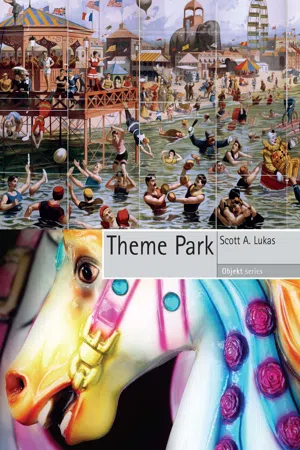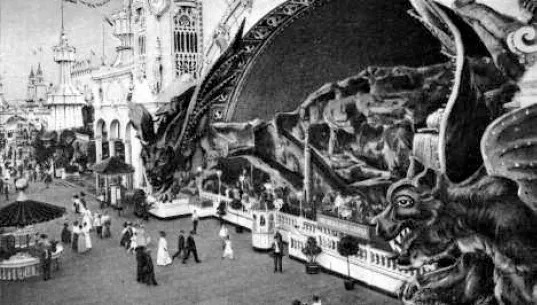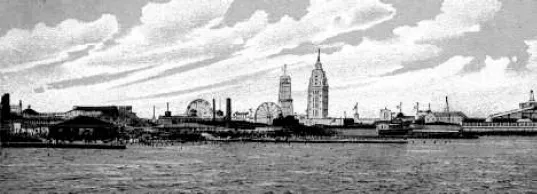![]()
1 Theme Park as Oasis
Hell is constructed of papier-mâché, and painted dark red. Everything in it is on fire – paper fire – and it is filled with the thick, dirty odor of grease. Hell is very badly done.
Maxim Gorky, on a visit to Coney Island.1
With his description of Coney Island, Maxim Gorky, the famous Marxist literary figure, launched one of the first polemics against the amusement park industry. Gorky’s words reflect an almost surrealistic description of Coney Island, as he writes of animal shows and varied attractions like Hell Gate and The Flood. Everywhere he finds what he detests, the ‘glittering boredom’ and the ‘varied boredom’ that characterize ride after ride and show after show. Like Tolstoy’s criticism of the 1893 World’s Columbian Exposition, Gorky fears the character of the amusements being proffered at Coney Island, yet he is also fascinated by it. Unlike Tolstoy he directly assaults the major foundation of amusement and theme parks – artifice. Pre-dating the post-1960s critiques of the ‘Disneyization’ (or ‘Disneyfication’) caused by the theme park industry, Gorky pinpoints one of the most significant relationships in the theme park, that between the artificial and the real.
Since Plato’s powerful image of the cave in The Republic people have been simultaneously trapped between the varying poles of the artificial and the real. And since cave art in prehistoric times people have been comfortable with the uneasy play between the real and the unreal. In the case of the contemporary theme park this idea has been widely expressed, if not overstated. Like Plato’s cave, theme parks provide the powerful illuminations of architecture, rides, shows and varied entertainment that cast shadows on and affect the people who visit them. What is debatable is what the effect of theme park amusements on people is. Is it slavish consumerism, as Gorky would have it, or is it meaningful, often nostalgic and joyful, as many who have visited theme parks would have it? Do the simulated architectural worlds of theme parks reflect who we are? To be able to deal with the contradictions of the artificial and the real, it would seem, is an essence of understanding the nature of any theme park.
The Dragon’s Gorge Scenic Railway at Luna Park offered fantasy escapism and thrilling propulsion of the body.
Well before Gorky’s diatribe against Coney Island powerful forms of artificiality that challenged the real and provided a refuge or oasis in contrast with the chaos of the outside world were taking root. These forces led to the emergence of the theme park but, as we shall see, they look nothing like the theme parks of the contemporary world. Throughout this book I hope to show that, contrary to attempts to trace a clear path from earlier amusement traditions like fairs and world expositions to the contemporary theme park, there is no linear path from these early amusements to their later kin. Instead we must understand the trajectory of the theme park in the form of historical whispers, thematic shouts in the night and rhizomatic influences of direction and misdirection. Like Jacques Derrida’s ‘différance’ the traces of the theme park, as much as they resemble the amusements of the past, are indirect. In the case of the earliest traces of the theme park we discover a significant architectural construction of the artificial-real.
The earliest of dwellings, whether adobe huts or early settlements, establish the important principle of the zone. Etymologically, zone refers to climatic regions of the earth, or to regions that are ‘distinguished from adjacent regions by some special quality or condition’.2 In the case of natural climatic zones there is no human intervention in the distinguishing of the zone, but in geography and architecture the ‘special quality or condition’ is deter mined by humans. With the earliest pleasure gardens, including Vauxhall Gardens, Ranelagh Gardens and Jenny’s Whim of London, the Prater of Vienna, Tivoli of Copenhagen and the picnic groves of the United States, including Jones’s Wood, the theme park emerges in the lush gardens and natural outdoor spaces that were landscaped, modified and connected to the pleasures of people. The utilitarian features of the landscape are combined with the altered features of entertainment geography and architecture. What early leisure gardens establish is not simply that humans may inhabit the land, but that they may modify it in synthetic ways that perfectly fuse the natural and the unnatural. The theme park, rather than being an unnatural abomination on the landscape, is a fusion of the utilitarian and the symbolic, the natural and the unnatural.
Vauxhall Gardens opened in the mid-nineteenth century and is considered by some to be the ‘first internationally famous pleasure garden’.3 At Vauxhall variety entertainment – including acrobatic performances, fireworks, dancing, music and food – was the norm. In 1728 a ‘season ticket’ was developed that allowed people to visit the gardens throughout the year.4 Spectacle, which would become the standard at amusement parks at Coney Island, was established with performances that included aeronauts descending from balloons and unfortunately included the death of one such performer.5 At a number of the gardens spectacles included performances like the re-creation of the Battle of Waterloo and the eruption of Mount Etna.6 This tradition of spectacle performance would later come full circle at Coney Island. London’s Ranelagh Gardens, popular in the mid-1700s, included lavish architectural features, such as a giant rotunda and a Chinese house, and offered games of chance to the public. During the years of Ranelagh’s prominence, the fireworks display became a staple of outdoor pleasure gardens, including at the Marylebone Gardens of London.7 Like the technological displays that take place in many theme and amusement parks of the present, fireworks provided the public with a pyrotechnic show that was unmatched at the time. The popularity of pleasure gardens like those of Vauxhall led to illegitimate franchising of the gardens. At least five ‘Vauxhall Gardens’ appeared in New York.8 A similar, also illegitimate transfer of the successful franchises of Coney Island amusement parks would take place in the United States in the early 1900s, as would later a counterfeit version of Disneyland at Shijingshan Amusement Park in Beijing, China and the now-closed Nara Dreamland in Japan. What such copying suggests is the emergence of an amusement tradition that, like the theme park, would be an immensely popular enterprise.
The roller coaster, though a synthetic and unnatural projection of human desire, must situate itself within nature.
At Jenny’s Whim, established in London in 1750, the lushness of the natural landscape was complemented with artificial means of amusement. Mechanical mermaids, fish and monsters were brought to mechanical life at a pond in the park.9 At Jenny’s Whim the use of special effects in the form of primitive animatronics established the important theme park technology of cybernetics, in which special effects and mechanical operations are used as entertainment interaction between patrons and the artificial.10 The Prater of Vienna, opened in 1766, provided another important impetus for the theme park. In addition to swings and primitive amusement rides, the Prater featured varied concessions, including stands that sold sausages.11 Similar to the later parks of Coney Island, the amusement zones of the Prater emphasized the participation of mixed social classes in the various forms of entertainment.12 Like the Prater the Tivoli of Copenhagen used the natural environment to create a unique amusement space for patrons. At Tivoli plants, buildings and entertainment areas fashioned a spatial division that would come full circle in the contemporary theme park, in which further spatial distinctions of theme lands are created.
Speaking of Tivoli, its architect George Carstensen offered that ‘Tivoli will never, so to speak, be finished’.13 Like the flux that characterized the updating of the many amusement parks of Coney Island, Tivoli established the idea that a successful theme park must be continually updated. In fact, years later, Walt Disney stated that ‘Disneyland will never be completed. It will continue to grow as long as there is imagination left in the world.’ The key way in which the pleasure garden affects the future and makes way for the theme park is the principle of multi-use entertainment space. The contemporary theme park is a holistic fusion of rides, shows, concessions and attractions. Whereas other forms of popular entertainment are conditioned by their nature – a cinema can generally only show motion pictures – the theme park, as influenced by the multi-use entertainment space of the pleasure garden and later the world exposition tradition, provides the patron with everything. All desires are met, with the only limit being the patron’s imagination and energy to partake in the amusements.
Tivoli (1860) and switchback railroad: an early form of the theme park begins to take shape.
It is unlikely that a contemporary theme park visitor would consider any of the famous pleasure gardens of Europe to be theme parks; in fact, they were not theme parks, but elaborate natural settings in which some future features of the theme park can be located. More influential to the modern theme park is the world exposition or world’s fair. While early pleasure gardens were limited in the amount of entertainment and variety amusement that could be provided, with world expositions, greater capital investment allowed more amusements and increased abundance. Populations expected superior attractions and more extravagant entertainment with each subsequent exposition. Within the amusement world of Coney Island, a similar expectation was created, in part fuelled by an amusement ‘arms race’ of sorts. As Dreamland helped illustrate, a penchant to copy popular attractions from one park, and in many cases make them bigger at the new park, soon became an amusement standard.14 In today’s theme park the emphasis on abundance continues. In some cases this occurs with amusement rides. Cedar Point, for example, can only claim to be the roller coaster capital of the world by constantly rein-vesting in more roller coasters in its park, for all the while other theme parks attempt to catch up to claim this distinction. In the desire for more – whether rides, thematic vistas or shows – both an economic and a symbolic accumulation take hold in the theme park.
An important aspect that is heralded by the world’s fair and later adopted in both the amusement park and theme park is the prominent role of commodity. Walter Benjamin, speaking of the 1867 Exposition Universelle in Paris, offered that the world expositions entertained ‘by elevating people to the level of commodities’.15 Like the trade fairs that preceded them world expositions relied on the commodity as a means of identity, and in the contemporary theme park the commodity has become the defining of all forms (see chapter Five). For the fairgoer attending an exposition meant not being an individual, but being part of a social drama of which commodity was both the catalyst and connector. Though some popular amusements, like cinema, are highly individualistic phenomena, the world’s fair ushered in an age of social consumption in which fairgoers could delight in viewing commodities on display alongside others. The fair became a palace of consumption, a hyperreal oasis of goods. This is a key development that is taken to an extreme in the kinaesthetic thrills of Steeplechase Park, and later modified at Disney theme parks and quasi-theme parks in Las Vegas. On their surface world’s fairs proclaim themselves to be complete entities, particularly as they display the commodities of architecture, technological invention and people themselves (in the case of anthropological displays). Yet, through their construction as complete spaces in and of themselves, world’s fairs promoted the important theme park principle of the total package. World’s fairs proved that through careful attention to architecture, performance and symbolism an enclosed space could be completely distinguished from other spaces. Just as the city promoted a new vision of the world, the world’s fair was ‘designed for a new sensibility’.16 While people never fully accepted the entertainments of the pleasure gardens as a new reality, with the world exposition a new tradition of the ‘real’ emerges.
View of Coney Island from the ocean (circa 1910), a sign of things to come in terms of the theme park and its impact on urbanization and sprawl.
Through their very design world’s fairs created distinctive entertainment zones with ‘clear boundaries … and coherence’.17 The most famous of all of the expositions is perhaps the World’s Columbian Exposition, held in Chicago in 1893. This world’s fair was such a draw that many families spent their life savings and burial money just to attend, and it is reported that one person, so obsessed with making the pilgrimage to Chicago, walked the entire length of the railroad tracks from Houston. While all expositions are heralded for their revolutionary effects on arch...




